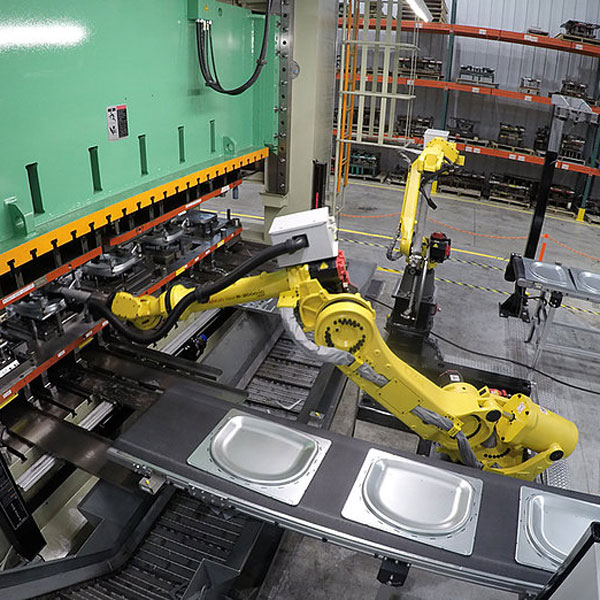Ultimate Guide to Metal Stamping Techniques and Applications
Ultimate Guide to Metal Stamping Techniques and Applications
Blog Article
Steel Marking Technologies: Elevating Production Processes for Superior Outcomes
In the world of producing processes, steel stamping has long been a foundation method for generating a range of precision components. With the relentless march of technical advancement, the landscape of steel marking is going through a substantial improvement.
Development of Metal Stamping Methods

Additionally, improvements in material science have actually led to the advancement of high-strength alloys that can currently be seamlessly stamped into complex forms, satisfying a broader series of commercial applications. The assimilation of robotics and synthetic knowledge has actually better optimized the stamping process by boosting rate and precision while reducing the risk of human error.

Effect of Advanced Materials
Have sophisticated materials changed metal marking procedures dramatically in the production industry? The solution is a definite yes (Metal Stamping). The assimilation of sophisticated products has changed steel stamping, allowing producers to attain greater accuracy, boosted effectiveness, and improved item high quality. By utilizing products such as high-strength alloys, progressed composites, and ingenious finishes, metal marking processes can currently create components that are lighter, stronger, and more sturdy than ever.
These sophisticated materials offer exceptional mechanical residential properties, corrosion resistance, and thermal stability, enabling makers to satisfy the needs of contemporary industries such as aerospace, vehicle, and electronic devices. In addition, the usage of advanced materials in metal stamping has assisted in the manufacturing of intricate geometries and intricate designs that were previously unattainable through conventional methods.
Additionally, the application of innovative products has actually caused minimized product waste, lower production expenses, and much shorter lead times, making metal stamping processes much more sustainable and economical. As technology remains to advance, the impact of advanced products on steel marking processes is expected to drive further technology and boost the competitiveness of makers in the worldwide market.
Automation in Metal Stamping
The evolution of metal marking procedures driven by the combination of sophisticated materials has actually set the phase for substantial advancements in automation within the production market. Automation in metal marking has actually reinvented production procedures, improving efficiency, accuracy, and general outcome quality. Via the usage of robotics, sensors, and computer-controlled systems, jobs that were when hand-operated and lengthy can now be carried out with unparalleled rate and accuracy.
Automation in steel stamping not just accelerates manufacturing rates however also makes certain consistency in the production procedure. By lessening human intervention, the threat of errors is dramatically minimized, leading to higher degrees of item uniformity and integrity. Additionally, automation makes it possible for producers to carry out complex stamping jobs that would be unwise or difficult to attain manually.
Furthermore, automation in steel marking contributes to a more secure working environment by minimizing the demand for employees to participate in dangerous or repetitive tasks - Metal Stamping. This change in the direction of automation not just improves performance however additionally paves the way for the future of manufacturing, where modern technology plays a central function in driving functional quality
Quality Control and Evaluation Systems
With an emphasis on accuracy and integrity, high quality control and examination systems play a vital duty in guaranteeing product excellence in metal stamping processes. These systems are developed to monitor every stage of production, from material inspection to the end product, resource to ensure that all parts meet the called for standards. By executing innovative innovations such as optical evaluation systems, coordinate determining devices redirected here (CMM), and automated assessing tools, suppliers can spot even the tiniest deviations in measurements, surface area quality, and overall integrity of stamped components.

Sustainability Practices in Metal Stamping
Structure upon the structure of precision and integrity developed through quality assurance and evaluation systems, the integration of lasting techniques in metal marking processes is significantly coming to be a focal point for producers looking for to lessen environmental impact and optimize resource utilization. Sustainability techniques in steel stamping include a variety of efforts targeted at minimizing waste generation, power usage, and greenhouse gas emissions throughout the production procedure.
One key aspect of sustainability in steel stamping is the adoption of environment-friendly materials and modern technologies that promote recyclability and waste reduction. By utilizing recycled products and carrying out energy-efficient equipment, suppliers can lower their carbon footprint and contribute to an extra lasting production cycle. Additionally, enhancing manufacturing procedures to lessen material waste and power usage not just benefits the setting however also causes set you back savings for companies in the lengthy run.
Moreover, the implementation of sustainable techniques in metal marking can improve brand online reputation and interest eco conscious customers. As sustainability remains to gain value in the manufacturing market, incorporating environment-friendly initiatives right into metal stamping procedures is crucial for long-term success and competition in the market.
Final Thought
In conclusion, steel marking techniques have dramatically evolved gradually, integrating innovative products and automation to boost making procedures. Quality assurance and evaluation systems play a crucial role in making sure superior results, while sustainability methods are progressively being carried out to reduce environmental impact. These advancements in steel marking have actually changed the sector, leading to more sustainable and efficient production techniques for numerous industries.
Metal marking, as soon as a handbook and labor-intensive procedure, has actually changed right into an extremely automated and sophisticated method of shaping steel sheets right into numerous kinds and layouts.Have sophisticated materials transformed metal marking procedures dramatically in the production market? By using materials such as high-strength alloys, advanced composites, and innovative coverings, steel marking processes can now produce elements that are lighter, stronger, and a lot more durable than ever in the past.
The advancement of metal stamping procedures driven by the assimilation of innovative materials has established the phase for considerable developments in automation within the manufacturing industry.In conclusion, steel stamping strategies have actually considerably browse around these guys evolved over time, incorporating innovative materials and automation to improve making procedures.
Report this page